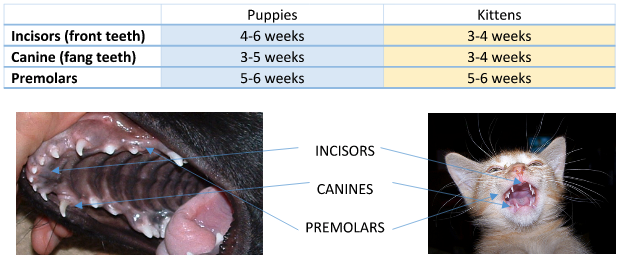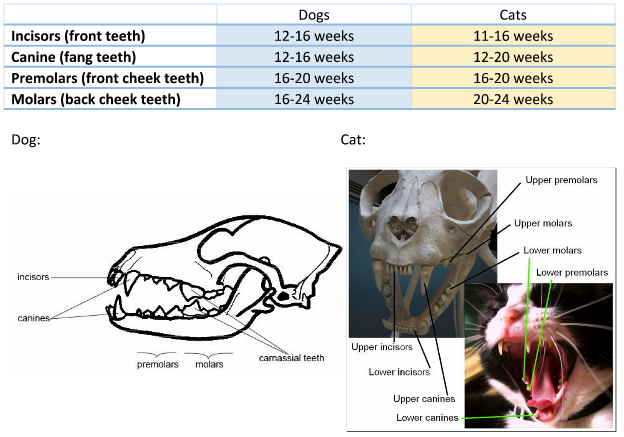When do my pet’s baby teeth come in?

When do my pet’s adult teeth come in?

FREQUENTLY ASKED QUESTIONS
What should I do if my cat’s baby teeth don’t fall out before the adult teeth grow in?
If your cat has a baby tooth and an adult tooth crowded, trying to be in the same position, it is not normal! As the adult tooth grows in, they should push the baby tooth out, and you should only ever see one tooth per spot. For example, it is common that a cat might have two fang teeth in the same location (one baby, and one adult). In this case, the baby tooth needs to be extracted by a veterinarian under general anesthesia.
What happens if there is a baby tooth still there and no adult tooth?
Sometimes, for many different reasons, your pet may not have an adult tooth, and the baby tooth may stay in place. These teeth are weaker than adult teeth and are smaller. As a result, sometimes these teeth are more prone to breaking or becoming damaged. Although, if the baby tooth is intact often it can be left alone.
What if there the baby tooth is gone, but I can’t see an adult tooth growing in?
In this case, you should have the mouth looked at by your veterinarian. Sometimes this is because there is no adult tooth. But in other cases, the adult tooth might be stuck underneath the gums. In this situation, the vet can put your animal under anesthesia and open the gums over top of the tooth to allow it to move out. Finally, occasionally while the adult tooth is stuck under the gums it can become encased in bone, and form a cyst or an abscess. In these cases, the adult tooth will have to be removed.
Is it painful when my puppy or kitten’s teeth are growing in?
Just like in a human baby, it can be painful for your pet when they are teething. At this time you don’t want to brush their teeth because then your pet can associate having their teeth brushed with pain. You also don’t want to irritate the mouth more than it already is, so it is recommended to feed soft food (no crunchy kibble), and to take away any toys that might be hard or cause trauma to the gums.
When can I start brushing my cat or dog’s teeth?
Brushing your animal’s teeth is an essential part of their oral hygiene, just like for humans! Although your pet’s baby teeth will fall out soon, it is recommended to get your pet used to having their teeth brushed at an early age. This will make brushing teeth much more comfortable for you and your pet in the long run! Once all of the teeth are in, and your pet is no longer teething (and there is no redness or irritation in the gums), you can start practicing a brushing routine. Once all the adult teeth are in, the best thing you can do for your pet’s teeth is to brush daily. As the adult teeth are coming in, be sure to look for any spots that are sore where the baby teeth have fallen out, and not irritate these areas, as your pet might start to think that having their teeth brushed hurts!
Written by Dr. Bassey, DVM